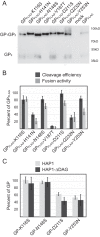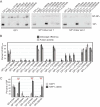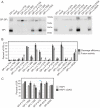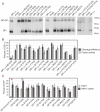Mutational Analysis of Lassa Virus Glycoprotein Highlights Regions Required for Alpha-Dystroglycan Utilization
- PMID: 28679759
- PMCID: PMC5571257
- DOI: 10.1128/JVI.00574-17
Mutational Analysis of Lassa Virus Glycoprotein Highlights Regions Required for Alpha-Dystroglycan Utilization
Abstract
Lassa virus (LASV) is an enveloped RNA virus endemic to West Africa and responsible for severe cases of hemorrhagic fever. Virus entry is mediated by the glycoprotein complex consisting of a stable-signal peptide, a receptor-binding subunit, GP1, and a viral-host membrane fusion subunit, GP2. Several cellular receptors can interact with the GP1 subunit and mediate viral entry, including alpha-dystroglycan (αDG) and lysosome-associated membrane protein 1 (LAMP1). In order to define the regions within GP1 that interact with the cellular receptors, we implemented insertional mutagenesis, carbohydrate shielding, and alanine scanning mutagenesis. Eighty GP constructs were engineered and evaluated for GP1-GP2 processing, surface expression, and the ability to mediate cell-to-cell fusion after low-pH exposure. To examine virus-to-cell entry, 49 constructs were incorporated onto vesicular stomatitis virus (VSV) pseudoparticles and transduction efficiencies were monitored in HAP1 and HAP1-ΔDAG1 cells that differentially produce the αDG cell surface receptor. Seven constructs retained efficient transduction in HAP1-ΔDAG1 cells yet poorly transduced HAP1 cells, suggesting that they are involved in αDG utilization. Residues H141, N146, F147, and Y150 cluster at the predicted central core of the trimeric interface and are important for GP-αDG interaction. Additionally, H92A-H93A, 150HA, 172HA, and 230HA displayed reduced transduction in both HAP1 and HAP1-ΔDAG1 cells, despite efficient cell-to-cell fusion activity. These mutations may interfere with interactions with the endosomal receptor LAMP1 or interfere at another stage in entry that is common to both cell lines. Insight gained from these data can aid in the development of more-effective entry inhibitors by blocking receptor interactions.IMPORTANCE Countries in which Lassa virus is endemic, such as Nigeria, Sierra Leone, Guinea, and Liberia, usually experience a seasonal outbreak of the virus from December to March. Currently, there is neither a preventative vaccine nor a therapeutic available to effectively treat severe Lassa fever. One way to thwart virus infection is to inhibit interaction with cellular receptors. It is known that the GP1 subunit of the Lassa glycoprotein complex plays a critical role in receptor recognition. Our results highlight a region within the Lassa virus GP1 protein that interacts with the cellular receptor alpha-dystroglycan. This information may be used for future development of new Lassa virus antivirals.
Keywords: arenavirus; receptor binding; virus entry.
Copyright © 2017 American Society for Microbiology.
Figures









References
-
- Frame JD, Baldwin JM Jr, Gocke DJ, Troup JM. 1970. Lassa fever, a new virus disease of man from West Africa. I. Clinical description and pathological findings. Am J Trop Med Hyg 19:670–676. - PubMed
-
- Ogbu O, Ajuluchukwu E, Uneke CJ. 2007. Lassa fever in West African sub-region: an overview. J Vector Borne Dis 44:1–11. - PubMed
Publication types
MeSH terms
Substances
Grants and funding
LinkOut - more resources
Full Text Sources
Other Literature Sources
Research Materials
Miscellaneous

